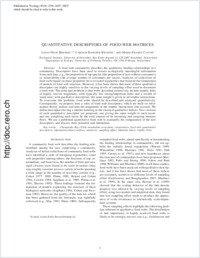Quantitative descriptors of food web matrices
- Bersier, Louis-Félix Department of Ecology,University of Fribourg, Switzerland - Zoological Institute, University of Neuchâtel,Switzerland
- Banašek-Richter, Carolin Zoological Institute, University of Neuchâtel,Switzerland
- Cattin, Marie-France Zoological Institute, University of Neuchâtel,Switzerland
-
2002
Published in:
- Ecology. - 2002, vol. 83, no. 9, p. 2394-2407
Chesapeake Bay (USA) mesohaline ecosystem
connectance
food web, quantitative descriptors
information-theory indices
omnivory
sampling effect
Shannon index
trophic links
English
A food web customarily describes the qualitative feeding relationships in a community. Descriptors have been used to extract ecologically meaningful information from such data, e.g., the proportion of top species (the proportion of taxa without consumers) or vulnerability (the average number of consumers per taxon). Analyses of collections of food webs based on these properties have revealed regularities that fostered the formulation of models of food-web structure. However, it has been shown that most of these qualitative descriptors are highly sensitive to the varying levels of sampling effort used to document a food web. The principal problem is that webs described extensively include trophic links of highly uneven magnitude, with typically few strong/important links and a wealth of weak ones; with qualitative descriptors, the same weight is given to all trophic interactions. To overcome this problem, food webs should be described and analyzed quantitatively. Consequently, we propose here a suite of food-web descriptors, which are built on information- theory indices and take the magnitude of the trophic interactions into account. We define descriptors having a similar meaning as the classical qualitative indices. Two versions of each quantitative descriptor are proposed, one giving the same weight to each taxon, and one weighting each taxon by the total amount of its incoming and outgoing biomass flows. We use a published quantitative food web to exemplify the computation of the new descriptors, and discuss their potential and limitations.
- Faculty
- Faculté des sciences et de médecine
- Department
- Département de Biologie
- Language
-
- English
- Classification
- Biological sciences
- License
-
License undefined
- Identifiers
-
- RERO DOC 12579
- DOI 10.1890/0012-9658(2002)083
- Persistent URL
- https://folia.unifr.ch/unifr/documents/301358
Statistics
Document views: 188
File downloads:
- pdf: 716
